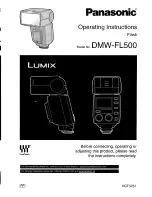
66
ķ
4.6 Flash synchronisation
4.6.1 Normal synchronisation (Fig. 7)
In normal synchronisation the flash unit is triggered at the beginning of the
shutter time (1st curtain synchronisation). Normal synchronisation is the
standard mode on all cameras, and is suitable for most flash shots. Depend-
ing upon the given mode, the camera is changed over to the camera’s sync
speed, the customary ones being between 1/30th sec. and 1/125th sec. (see
the camera’s operating instructions). No settings have to be made on the
flash unit, nor is there any display for this mode.
4.6.2 REAR - Second-curtain synchronisation (Fig. 8)
Some cameras offer the facility of second-curtain synchronisation (REAR
mode) triggering the flash unit by the end of the exposure time. Second-cur-
tain synchronisation is particularly advantageous when using slow shutter
speeds (slower than 1/30 s) or when shooting moving objects that have their
own source of light. Second-curtain synchronisation gives a more realistic
impression of movement because the light streaks behind the light source
instead of building up in front of it, as is the case when the flash is synchron-
ised with the 1st shutter curtain! Depending on its operating mode, the ca-
mera uses shutter speeds slower than its sync speed.
The REAR function can only be used if the flash unit is mounted on a
camera that supports this function. The camera must be switched on
to select and set this function. The camera’s shutter release must be
briefly touched so that the corresponding data can be exchanged at
least once between the camera and the flash unit. On some cameras
the REAR function is not possible in certain operating modes (e.g.
Green Full Auto Mode or Programmed Image Control Mode) so that it
cannot be selected. It will then be automatically deleted. Please also
refer to the camera’s instruction manual.
The REAR function can neither be selected nor adjusted on the flash
unit if FP high-speed synchronisation (HSS) is activated. To be able to
select the REAR function you must deactivate the high-speed synchro-
nisation (see 4.6.4).
☞
☞
Switching on the REAR mode
• Continue depressing the „Select“ key combination (= „Mode“ key + „Zoom“
key) until „REAR“ appears on the LC display.
• Continue depressing the „Zoom“ key until „ON“ flashes on the LC display.
• The setting becomes immediately effective. The LC display is returned its
normal state after approx. 5 sec.
The „REAR“ symbol for 2nd curtain synchronisation continues to be indicated
on the LC display of the flash unit after it has been set.
Always use a tripod to avoid camera shake with slow shutter speeds! Do
not forget to switch off this function after exposure, otherwise unintended
slow shutter speeds will conntinue to be used for „normal“ flash shots.
Switching off the REAR mode
• Continue depressing the „Select“ key combination (= „Mode“ key + „Zoom“
key) until „REAR“ appears on the LC display.
• Continue depressing the „Zoom“ key until „OFF“ flashes on the LC display.
• The setting becomes immediately effective. The LC display is returned to its
normal state after approx. 5 sec.
The „REAR“ symbol for 2nd curtain synchronisation is no longer indicated by
the display of the flash unit. The flash unit is then once again synchronised
with the first curtain (normal synchronisation).
4.6.3 Slow synchronisation / SLOW
Various cameras feature slow flash synchronisation in certain modes. This
setting will give added prominence to the background at lower ambient light
levels. This is achieved by matching the shutter speed to the ambient light.
Accordingly, shutter speeds that are slower than the flash sync speed are
automatically adjusted by the camera. Some cameras automatically activate
SLOW synchronisation in connection with certain camera programs (e.g.
„Av“ aperture priority, night shots program, etc.). No settings are made on
the flash unit nor is there any display for this mode.
Use a tripod to avoid camera shake with slow shutter speeds!
☞
☞











































